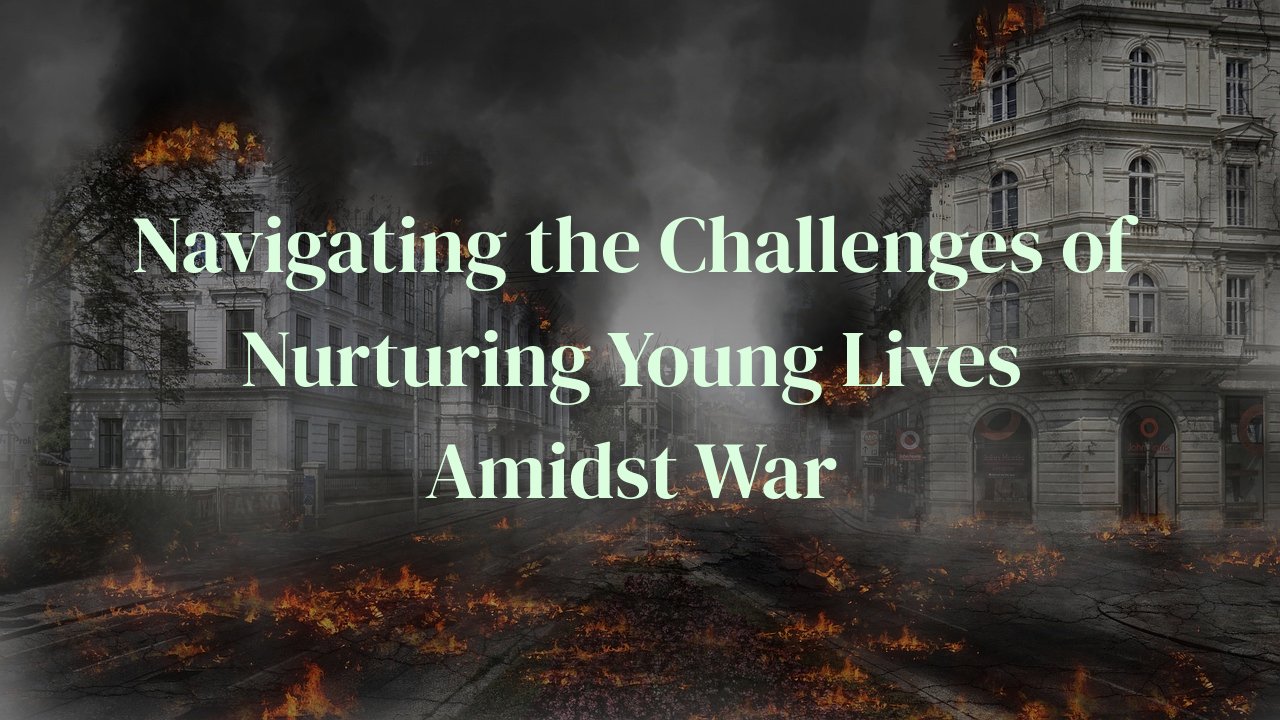
In the sobering reality where battlefields and domestic life collide, the task of ensuring a child’s health and well-being takes on daunting new dimensions. This blog post is dedicated to unraveling the complexities of pediatric care for children born in conflict zones. By venturing into this critical topic, we aim not only to highlight the adversity faced by these young lives but also to provide actionable insights and strategies for healthcare professionals, humanitarian workers, and policymakers dedicated to making a difference.
Readers will gain a deeper understanding of the unique medical and psychological needs of these children, the infrastructure hurdles in delivering care, and the innovative approaches to overcoming such challenges. As a seasoned expert in medicine and dietary therapy with ground experience, I share firsthand accounts and evidence-based strategies that can shape effective interventions for children caught in the crossfire of conflict.
Table of Contents
The Landscape of Pediatric Healthcare in Warfare
Warfare shatters the infrastructure of entire societies, leaving the weak and vulnerable to suffer the most. In this fragile environment, providing pediatric care for children born in conflict zones becomes an extraordinary challenge. As someone who has observed these hardships, I’ve seen firsthand the lack of basic facilities. Medical supplies are scarce; hospitals are often non-existent or become targets themselves. Healthcare professionals work under the threat of violence, striving to offer the care that these young lives so desperately need.
The physical landscape is often a tangible representation of the devastation: bombed-out buildings replacing where a clinic might have stood, emergency tents rather than sanitized wards, understaffed and overburdened makeshift hospitals devoid of essential medications. Each of these factors escalates the difficulty in delivering pediatric care. Children with conditions that would be readily treated in peacetime, such as asthma or diabetes, face life-threatening situations due to the unavailability of medication or proper management.
Amidst the ravages of war, mobile and field hospitals attempt to fill the gaping need where fixed facilities have been lost. Foreign aid and NGOs play a critical role in supplementing resources, but their presence is unpredictable and often hampered by security concerns. In such scenarios, medics are forced to improvise treatments and prioritize emergent cases over long-term care, which can be a heart-wrenching process when every child’s life is worth saving.
Despite the instability, healthcare workers in these zones show remarkable resilience and adaptability. They evolve not only into caregivers but also into teachers, counsellors, and protectors. The spirit of solidarity that grows in these makeshift medical facilities is inspiring, as local and international staff work together to provide a semblance of normalcy and healing to those affected by the constant specter of violence. Their efforts are nothing short of heroic, delivering hope where it seems lost, nurturing young lives amidst the seemingly insurmountable chaos of war.
Understanding the Unique Health Risks to Children in Conflict
In the dust and chaos of warfare, the most haunting cries are those of children – the silent victims of conflict’s relentless cruelty. Children born in the tumult of war zones are thrust into a world where the very air they breathe is saturated with peril. From my experiences working in makeshift clinics near frontlines, I’ve witnessed firsthand the spectrum of health risks these young souls face, risks that extend far beyond the immediate danger of violence.
Among the plethora of threats, infectious diseases run rampant due to the collapse of sanitation systems and crowded living conditions in refugee camps. A simple cut can spell a death sentence when antibiotics are but a relic of a more peaceful past. Malnourishment, another grim specter, stalks the young, stunting bodies and minds, and laying the foundation for chronic disease. Vaccine-preventable illnesses, a thing of the past in developed regions, emerge as harbingers of death when supply chains are severed by blockades and bombings.
Moreover, the psychological trauma inflicted upon these innocent beings molds scars not easily seen but felt deep within their psyche. The sound of exploding ordnance becomes a lullaby of terror, forever etched in their memories. Wounds of the flesh may eventually heal, but those of the mind fester without the salve of stability and peace. Thus, addressing the mental health needs of these children is as critical as tending to their physical injuries.
Perhaps the most insidious risk, though, is the loss of hope. Being born into a world devoid of the simple joys of childhood, where education is a luxury and the future a bleak horizon, can quash the inherent potential within every child. The nurturing of young minds is often a casualty of conflict, leaving a generation lost to the brutal legacy of war.
As I wrap each tiny wound and hold each fragile hand, I am reminded that these are not just bodies to be healed, but futures to be salvaged. The unique health risks children face in conflict zones are manifold and profound, demanding our steadfast commitment to compassion and ingenuity in the face of despair. Only then can we hope to mend not just the broken bones but also the shattered dreams of these youngest victims of human strife.
Strategies for Delivering Medical Care under Fire
Witnessing the devastating impacts of war on children firsthand has imbued my efforts to deliver pediatric care with urgency and depth. Among the harrowing sounds of conflict, the resilience of healthcare professionals and the innocence of children create a stark contrast. One pivotal strategy is the establishment of mobile clinics, which are agile and can navigate through the shifting frontlines to reach children in need. These clinics carry essential medication and staff trained in trauma care, proving invaluable in resource-constrained environments.
Equally critical is the training of local volunteers. This initiative builds capacity within communities as local individuals become the first line of defense, administering basic care to the injured and facilitating vaccinations. They become the unsung heroes, working tirelessly, often with limited resources, to safeguard their community’s health.
In the spirit of ‘leave no one behind’, we’ve seen the emergence of telemedicine as a beacon of hope. Through this, pediatric specialists from across the globe can guide on-the-ground personnel through complex procedures and diagnoses, effectively breaching barriers imposed by the conflict.
The distribution of emergency health kits has also been pivotal. These kits are filled with antibiotics, rehydration salts, bandages, and other basic yet life-saving supplies. Their simplicity belies their impact, especially when they reach besieged areas where every single pill can mean the difference between life and despair.
Lastly, partnerships with humanitarian organizations play a key role. They provide not just logistical support, like the safe passage of supplies, but also raise awareness and necessary funds. Their networks can transform the landscape of pediatric care in warzones, echoing the call for peace and children’s right to health.
Nutrition and Dietary Needs: Sustaining the Young in Siege
As I etch these words, the memories of my time delivering aid in conflict-torn regions flicker before me, a stark reminder of the adversity faced by the young lives I encountered. In these areas, where the cacophony of war drowns out the laughter of children, meeting nutritional and dietary needs is a formidable challenge – one that is as much about ingenuity as it is about medicine.
Within the besieged walls, access to fresh food is often a distant dream. The focus shifts to maximizing the nutritional value of limited supplies while ensuring that what is available caters to the unique requirements of growing children. Nutrient-dense foods, such as legumes and pulses, become a cornerstone of sustenance. They are compact, easily stored, and rich in proteins vital for growth and repair – a veritable treasure in settings where every morsel counts.
When fresh produce is but a rare luxury, multivitamin supplementation can be lifesaving. During my fieldwork, we prioritized the distribution of vitamin A and zinc supplements to support immune function and mitigate the risks of common childhood diseases. A simple tablet tucked in the pocket of aid workers, seemingly inconspicuous, yet potent enough to ward off the specter of deficiency.
In the throes of conflict, breastfeeding becomes a stealthy weapon. Mothers, often undernourished themselves, are encouraged to continue breastfeeding for it offers a blanket of immunity to infants in settings where contamination haunts the very essence of survival – water. Breast milk, unrivalled in its nutritional composition, becomes the bastion against hunger and infant mortality amid the chaos.
Developing fortification strategies for what limited food supplies exist remains pivotal. Flour and oil, when available, are laced with essential vitamins and minerals under the guide of humanitarian programs I had the honor to be part of. This covert nourishment serves as a bulwark, armoring children against anemia and stunting, silent predators that lurk beneath the surface of war’s apparent wounds.
No story of nutrition in the siege could forgo the ingenuity of mothers and caregivers who, against all odds, weave resilience into every meal. One recollection refuses to fade – a garden of hope amidst rubble, where women cultivated herbs and vegetables in improvised pots. This small act of defiance, an ephemeral patch of green, was their testament to life. Here, amidst the semblance of normalcy, children learned the language of flavors not tainted by gunpowder.
Conclusively, sustaining the young in the tight grip of siege necessitates creativity and unwavering dedication. It requires us to tap into the formidable human spirit, to find an oasis of nutrition where desolation seeks to reign. As I recount these experiences, my heart salutes the undying resolve of those fighting not with weapons, but with hope, one meal at a time.
Building Resilience: Psychological Support for the Most Vulnerable
In the haunting terrain of war-stricken environments, the invisible scars borne by its youngest victims often tell stories deeper than visual wounds. Acknowledging this, ‘Building Resilience’ becomes not just a chapter in care but the essence of survival for these young souls. As a healthcare observer and empathetic chronicler, I’ve seen resilience embodied in the hearts of children who have weathered the unyielding storms of conflict.
One fundamental aspect of nurturing psychological resilience is through the provision of trauma-focused therapy. I’ve noted that normalizing the discussion of experiences and emotions in safe spaces can profoundly impact a child’s recovery from trauma. Such interventions often employ play and art therapy, which allow children to express and process complex feelings in a non-verbal, comforting manner, stimulating psychological healing.
Another key strategy is fostering community support systems. Communities serve as extended families during crises. I recall a poignant case where a local teacher organized group storytelling sessions. These gatherings were not only an escape but a communal lifeline, reinforcing the notion that no child faced adversity alone.
Educational continuity, though challenging, is a pillar of psychological stability in these settings. The act of learning in its own right creates a semblance of order amidst chaos. Through the creation of makeshift classrooms, I’ve witnessed the restoration of a child’s cognitive growth and a gradual return of focus and purpose, crucial for long-term mental health.
Perhaps most essentially, the presence of consistent caregivers, whether family or assigned guardians, cannot be overstated. Their unwavering support acts as a buffer against the torrent of instability. Guardians become the child’s compass, guiding them to hope and instilling a belief in a secure future.
Integral to this entire framework is the consistent monitoring of progress and the flexibility to adapt therapeutic approaches as each child’s needs evolve. I’ve learned through my observations and interactions that the resilience of the human spirit, especially in children, can flourish even through the deepest adversity. In this, we find not just strategies, but testament to the extraordinary ability of young lives to not just survive, but eventually thrive.
Conclusion
In the face of conflict, children are the silent sufferers whose stories often remain untold. As we conclude this exploration, it’s clear that pediatric care for children born in conflict zones demands not only a breadth of knowledge but also a deep well of compassion and innovation. By investing in tailored healthcare strategies and supporting those on the front lines, we contribute to a brighter future for these young individuals, cultivating hope and healing in places where it’s most needed.



